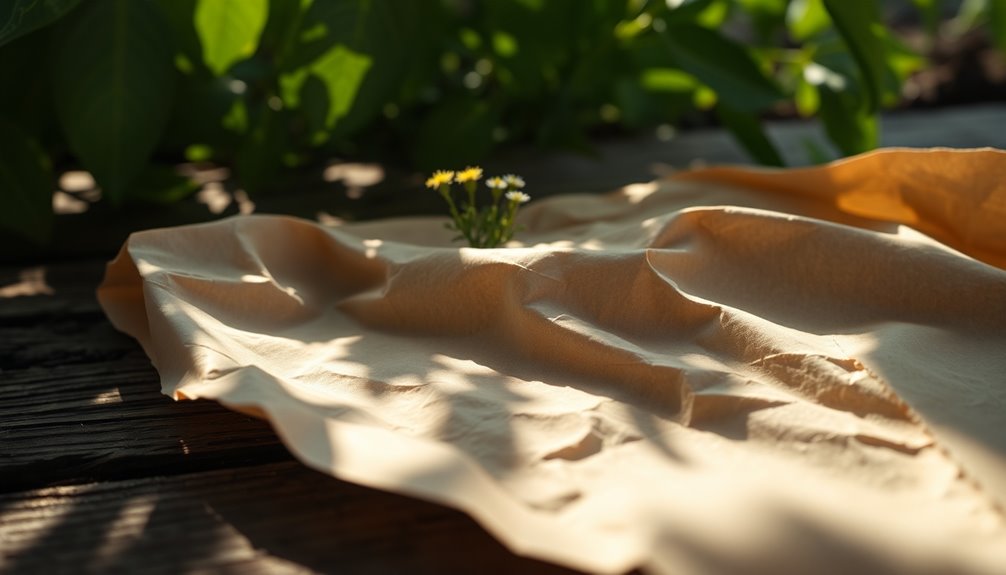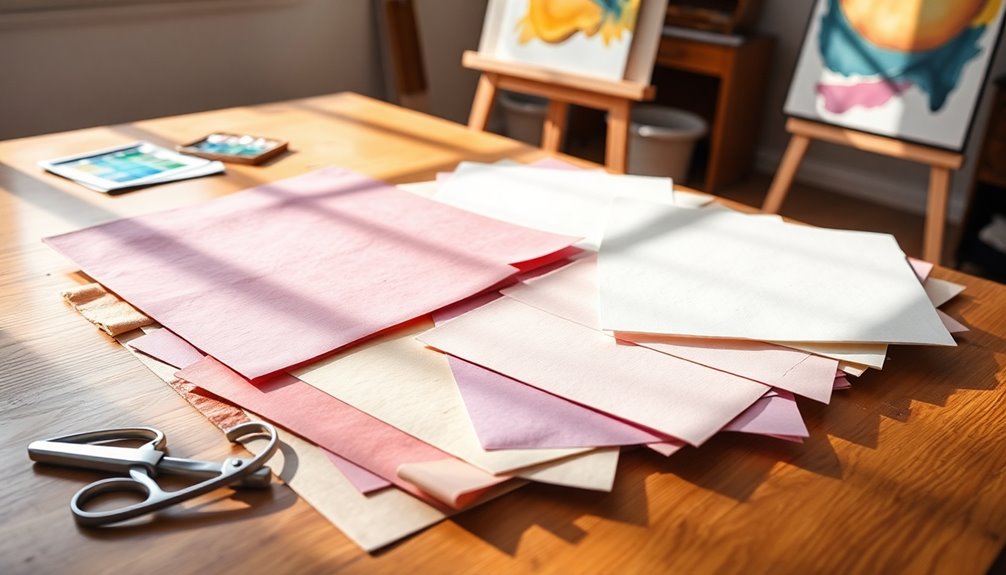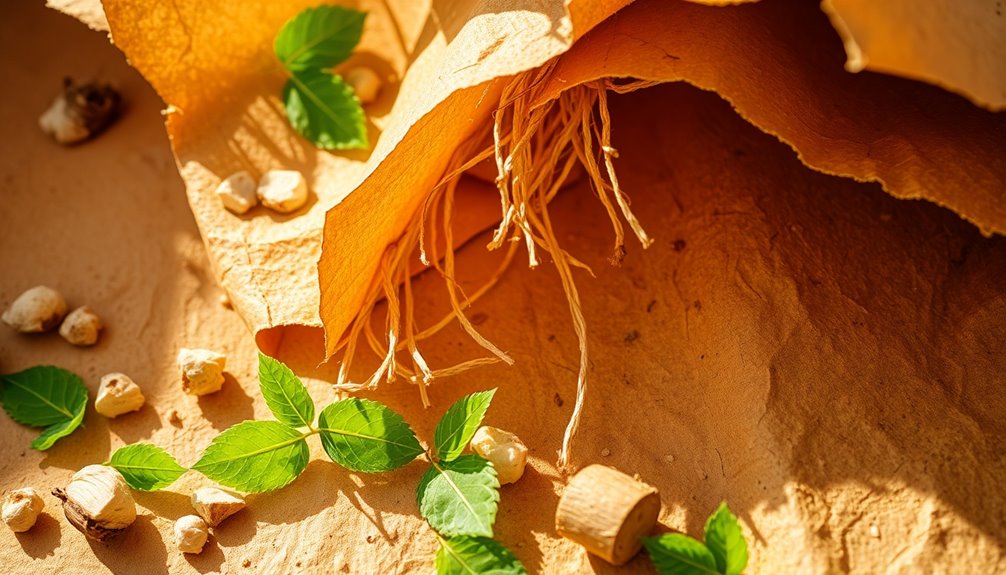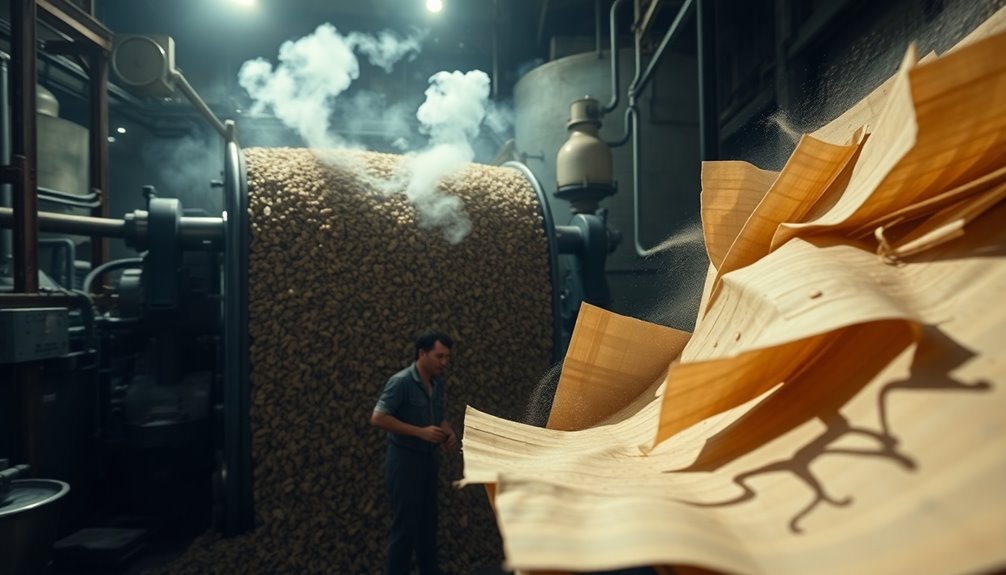Yes, Kraft paper is fully biodegradable. It breaks down naturally within weeks, thanks to its uncoated and eco-friendly composition. Made from natural wood fibers, it returns organic matter to the soil during decomposition, enriching it in the process. Unlike synthetic materials, Kraft paper helps reduce landfill waste and supports sustainability initiatives. You can feel good using it, knowing it doesn't leave harmful residues behind. This makes it a popular choice for eco-conscious packaging. If you're curious about its production, environmental impact, or how it compares to other materials, you'll find more interesting details ahead.
Key Takeaways
- Kraft paper is 100% biodegradable, breaking down naturally within weeks under proper conditions.
- Its uncoated nature facilitates easier decomposition, enriching soil when composted.
- Unlike synthetic materials, Kraft paper significantly reduces landfill waste, supporting sustainability goals.
- It does not leave harmful residues after decomposition, promoting a healthier environment.
- Kraft paper's production emphasizes sustainable practices, making it a responsible choice for eco-conscious consumers.
Understanding Kraft Paper
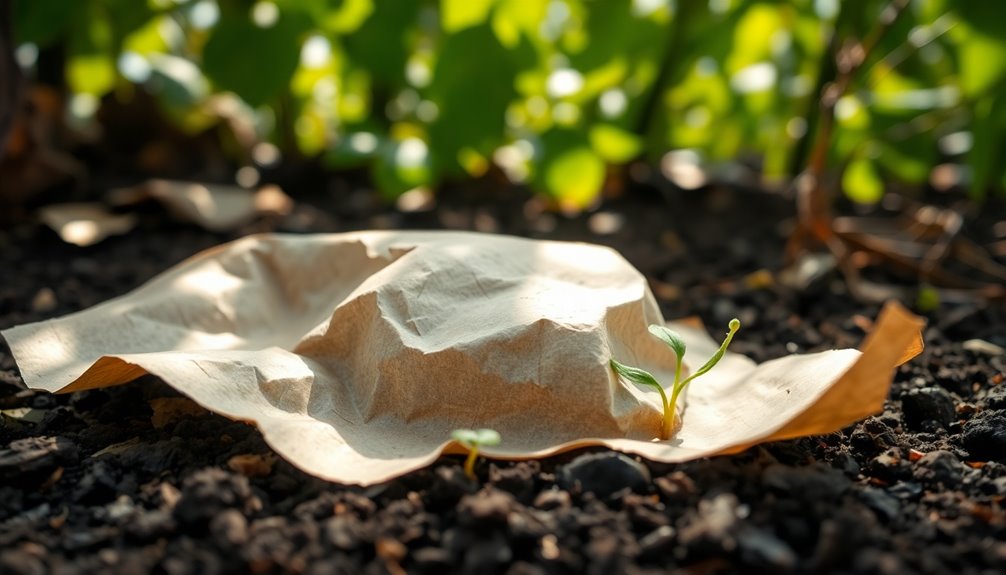
Understanding Kraft Paper begins with recognizing its natural composition. Kraft paper is made from virgin pulp or natural wood fibers, ensuring it's eco-friendly.
You'll notice it's unbleached, retaining its dark brown color, which minimizes the use of harmful chemicals during production. This aspect not only makes it better for the environment but also reflects its commitment to sustainable practices.
When you consider disposal, Kraft paper shines as a fully biodegradable option. It breaks down naturally within weeks when placed in appropriate conditions, meaning you can feel good about your environmental impact.
Additionally, it's recyclable, supporting circular economy initiatives. You can recycle Kraft paper multiple times before it reaches the end of its life, contributing further to sustainability.
Kraft Paper Production Process
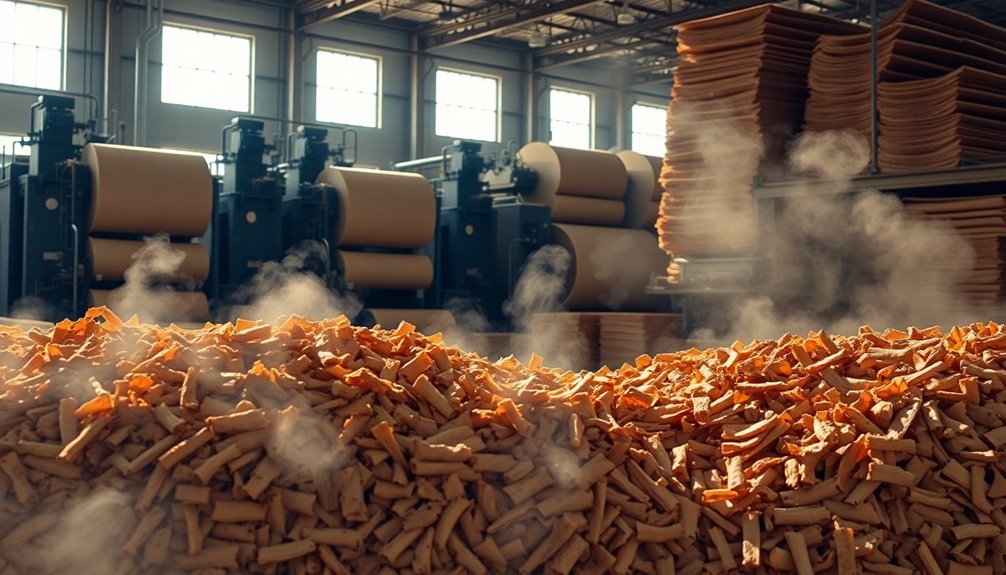
When you look at how kraft paper is made, you'll find it's all about pulping and fiber extraction.
This process uses chemicals to efficiently break down wood chips, while also focusing on recovering those chemicals for reuse.
With minimal bleaching, the production maintains the paper's strength and eco-friendliness, resulting in that signature dark brown color.
Pulping and Fiber Extraction
The Kraft paper production process begins with the efficient extraction of cellulose from wood chips, a method that showcases both innovation and environmental responsibility.
In Kraft pulping, you cook natural wood chips under pressure to break down the lignin that binds the cellulose fibers. This cooking process utilizes sodium sulfide, which not only helps loosen the fibers but also minimizes environmental impact by allowing the recovery and reuse of about 90% of the pulping chemicals.
What's remarkable about this method is the higher sulfur ratio it employs compared to other paper types. This contributes to the strength and integrity of the cellulose fibers, making the final product robust.
Additionally, the minimal use of bleaching agents during production guarantees that the fibers retain their natural strength and characteristics, avoiding excessive chemical treatments that could harm the environment.
The outcome of this meticulous process is durable, unbleached Kraft paper that aligns with eco-friendly practices.
Chemical Usage and Recovery
In Kraft paper production, chemical usage plays an essential role in enhancing efficiency while minimizing environmental impact. Sodium sulfide is a key chemical that helps you efficiently loosen wood fibers and remove lignin, resulting in high-quality pulp. This process is more sustainable than traditional methods, as it emphasizes using fewer harmful chemicals overall.
What's impressive is that around 90% of the pulping chemicals used in the Kraft process can be recovered and reused. This recovery considerably reduces waste and limits the environmental footprint of paper production. By reusing these chemicals, you contribute to a more circular economy, promoting the use of recycled content in your products.
Furthermore, the reduced chemical usage during Kraft paper production not only helps preserve the natural strength of the fibers but also aids in making the paper biodegradable. As a result, Kraft paper can break down naturally in a matter of weeks, aligning with eco-friendly practices.
Minimal Bleaching Process
Minimizing bleaching during Kraft paper production not only preserves the strength of cellulose fibers but also considerably reduces the use of harmful chemicals. By focusing on a minimal bleaching process, you maintain the integrity of the fibers, which is essential for producing high-quality Kraft paper. This unbleached nature contributes to its natural brown color, ensuring that fewer chemical treatments are involved and enhancing its biodegradable characteristics.
In this process, about 90% of the pulping chemicals can be recovered and reused. This aspect promotes sustainability, as it lessens waste and environmental impact. The higher sulfur ratio in Kraft paper compared to other types of paper further boosts its durability and longevity, making it a more sustainable choice overall.
When you dispose of Kraft paper, it can break down naturally within weeks, thanks to its minimal chemical treatments. This fast decomposition supports its biodegradable characteristics, making it an eco-friendly option for various applications.
Biodegradability of Kraft Paper
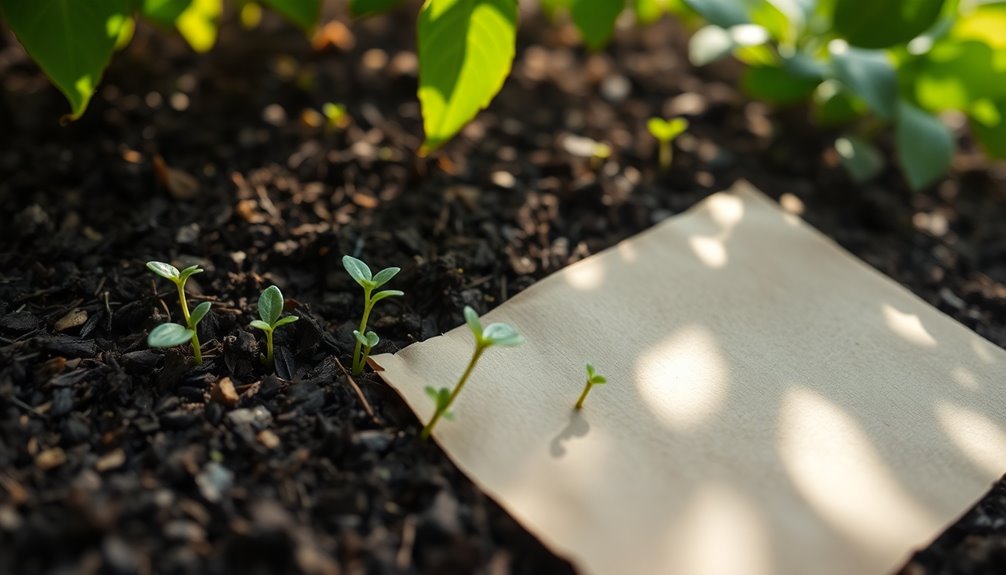
When you consider the biodegradability of kraft paper, you'll find it breaks down naturally within weeks in the right conditions.
This natural decomposition process not only reduces environmental impact but also offers a stark contrast to other materials that linger in landfills.
Understanding these factors helps you appreciate why kraft paper is favored in eco-friendly packaging solutions.
Natural Decomposition Process
Kraft paper showcases impressive biodegradability, breaking down naturally within weeks under the right environmental conditions. This means that when you dispose of kraft paper properly, it doesn't linger in landfills for years like synthetic materials do.
Its uncoated nature minimizes chemical treatments, which allows it to decompose more easily in composting environments. Made from natural wood fibers, kraft paper enhances its ability to break down, making it a truly eco-friendly alternative.
When you toss it into a compost pile, it contributes valuable organic matter back to the soil, enriching it rather than polluting it. By choosing biodegradable kraft paper for your packaging or crafts, you're actively supporting sustainability goals and reducing waste accumulation.
If you're conscious about your environmental footprint, opting for kraft paper instead of plastic or other synthetic options is a great step. Not only does it decompose efficiently, but it also aligns with efforts to promote a healthier planet.
Environmental Impact Assessment
The environmental impact of kraft paper is overwhelmingly positive, especially when you consider its biodegradability. This material is 100% biodegradable, breaking down naturally in just weeks under the right conditions. By choosing kraft paper, you greatly reduce landfill waste, which is a vital step in promoting a healthier planet.
What sets kraft paper apart is its unbleached nature, minimizing harmful chemical treatments. This factor enhances its biodegradability and makes it a safer choice for the environment. When you compost kraft paper, it enriches the soil with valuable organic matter, promoting healthy plant growth and supporting local ecosystems.
The biodegradation process of kraft paper occurs without leaving harmful residues, establishing it as an eco-friendly packaging option. By opting for kraft paper, you align yourself with the growing consumer demand for sustainable materials.
This choice helps mitigate plastic pollution and supports eco-conscious practices, making a tangible difference in the fight against environmental degradation.
#
Comparison With Other Materials
Many consumers are increasingly looking for sustainable packaging options, and kraft paper stands out due to its impressive biodegradability. Unlike plastic, which can linger in landfills for hundreds of years, kraft paper decomposes naturally within weeks. This rapid breakdown makes it an environmentally friendly alternative that greatly reduces waste.
When you consider coated papers, many contain non-biodegradable components, but uncoated kraft paper is 100% compostable. Its minimal chemical treatments during the kraft process further enhance its biodegradability, ensuring no harmful residues are left behind.
In comparison to traditional paper options, kraft paper's eco-friendly profile is hard to beat. Its production process emphasizes sustainability, aligning perfectly with your preferences for packaging that won't contribute to plastic pollution.
Choosing kraft paper not only supports waste reduction but also promotes a greener planet.
Environmental Benefits of Kraft Paper

When it comes to eco-friendly materials, Kraft paper stands out due to its impressive environmental benefits. It's 100% biodegradable, breaking down naturally within weeks. This characteristic helps reduce waste in landfills, making a significant impact on our environment.
Since it's compostable, Kraft paper decomposes effectively, enriching the soil and supporting plant growth.
The production process of Kraft paper emphasizes sustainable practices, utilizing renewable resources and minimizing environmental impact. Without synthetic polymers, it eliminates plastic pollution, aligning with eco-friendly consumer preferences.
You can feel good knowing that choosing Kraft paper supports a cleaner planet.
Moreover, using Kraft paper promotes circular economy initiatives by encouraging recycling and reusing materials. This not only enhances sustainability efforts but also demonstrates a commitment to responsible consumption.
## Comparison With Other Materials
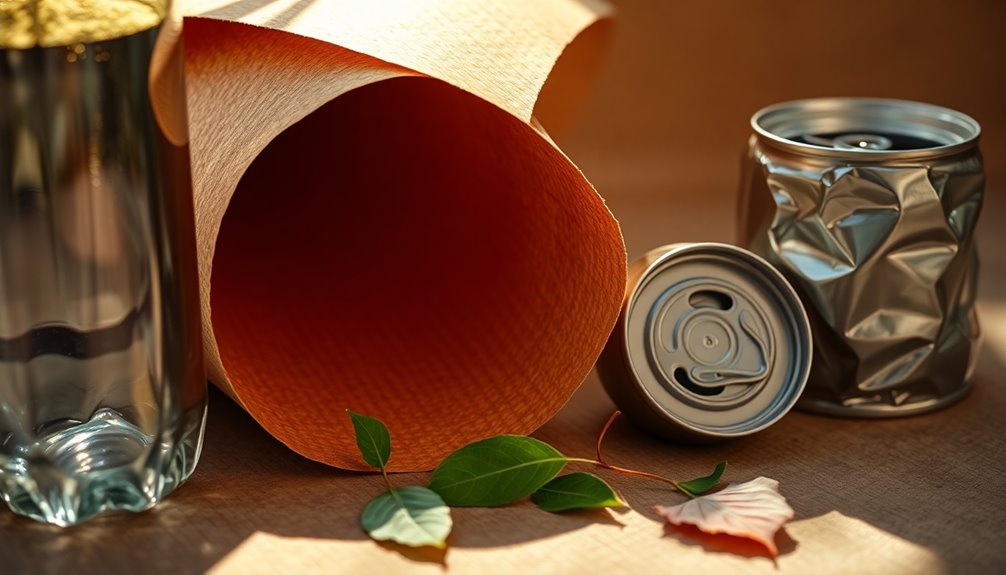
In recent years, the need for sustainable materials has become more urgent, prompting consumers to compare their options. When you look at Kraft paper, it stands out as a highly biodegradable choice.
Here's how it compares to other materials:
- Kraft Paper: Fully biodegradable, it breaks down naturally within weeks, thanks to its high cellulose content.
- Conventional Paper: While also biodegradable, it often involves more chemicals in its production, making it less eco-friendly than Kraft paper.
- Plastic: This material can linger in landfills for hundreds of years, posing serious environmental concerns due to its non-biodegradable nature.
- Styrofoam: Like plastic, Styrofoam is non-biodegradable and can take an eternity to decompose, contributing to pollution and waste.
Kraft paper's ability to decompose quickly makes it a superior choice for those looking to make environmentally conscious decisions. Additionally, the historical context of butter production illustrates how traditional practices can evolve toward sustainability, just like the shift toward more eco-friendly materials. Unlike some coated papers that inhibit biodegradation, uncoated Kraft paper retains its compostable properties.
Uses and Applications of Kraft Paper
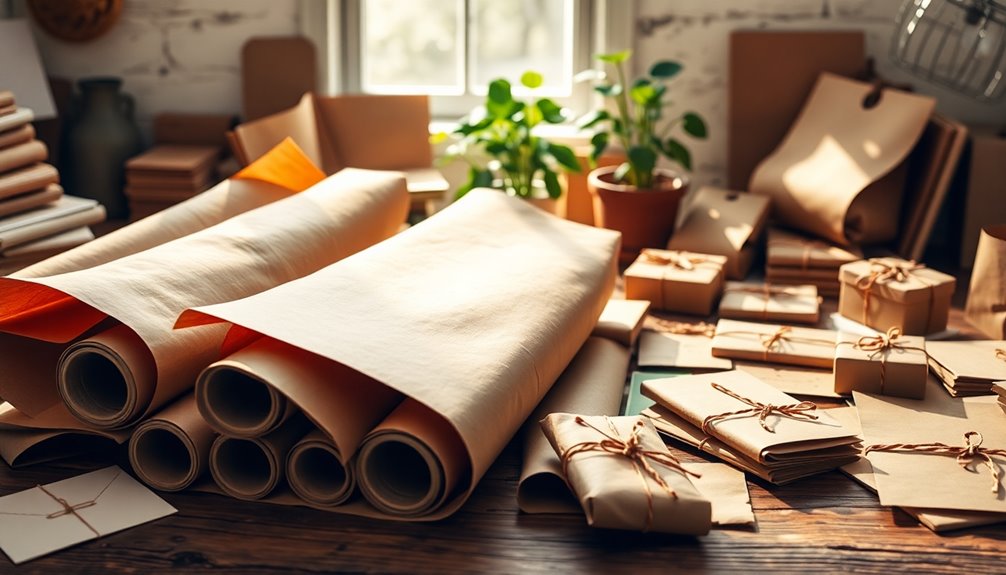
Kraft paper's biodegradability and eco-friendliness make it a popular choice across various industries. If you're looking for a sustainable packaging material, kraft paper is your go-to option. Many businesses use it for eco-friendly branded wrapping, which appeals to environmentally conscious consumers. Its lightweight yet durable properties guarantee that fragile items remain protected during shipping and handling.
You'll find that kraft paper is incredibly versatile. It can be transformed into sturdy paper bags or custom-printed totes, catering to different market needs. This adaptability allows you to create unique packaging solutions across various industries, enhancing your product's appeal.
Moreover, the natural texture of kraft paper adds an aesthetic value to your products, aligning perfectly with brands that focus on sustainability and a nature-themed look. Since it's 100% compostable and recyclable, using kraft paper supports sustainable packaging practices while reducing reliance on petroleum-based materials.
Sustainable Packaging Solutions
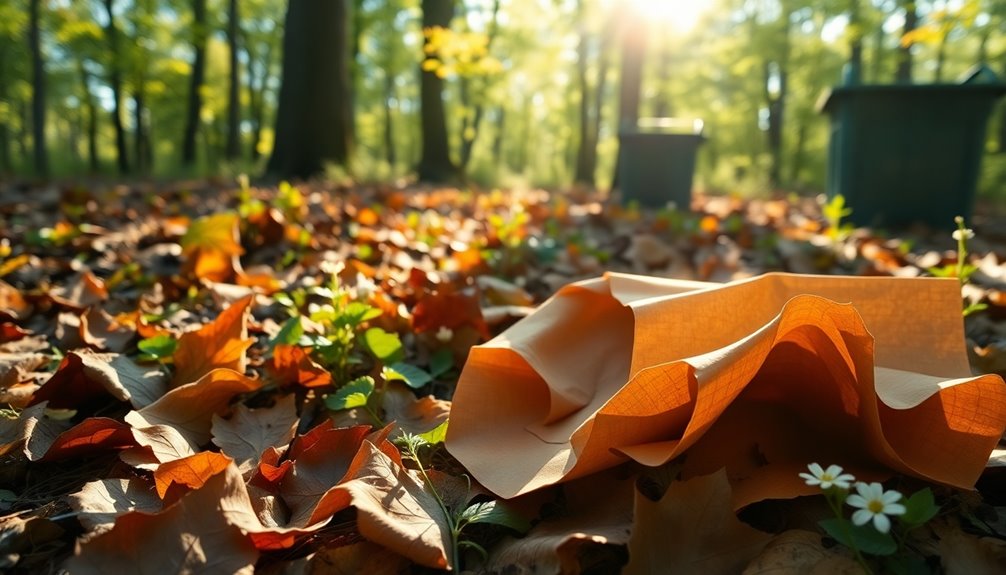
Sustainable packaging solutions are increasingly essential in today's eco-conscious market. One of the best options available is Kraft paper packaging, which offers a multitude of benefits for both consumers and businesses.
Here are four reasons why you should consider it:
- 100% Compostable: Kraft paper is fully compostable and biodegrades naturally within weeks, making it a fantastic choice for eco-friendly packaging.
- Renewable Resources: It's produced using sustainable practices and renewable raw materials like wood, ensuring minimal environmental impact.
- Reusability and Recycling: Kraft paper can be reused and recycled, helping prevent waste accumulation in landfills and supporting circular economy initiatives.
- Consumer Appeal: Using Kraft paper aligns with the growing consumer preference for environmentally conscious brands, enhancing your brand's responsibility and sustainability efforts. Additionally, choosing sustainable materials like Kraft paper contributes to reducing plastic waste and promotes a healthier planet.
Consumer Preferences and Trends
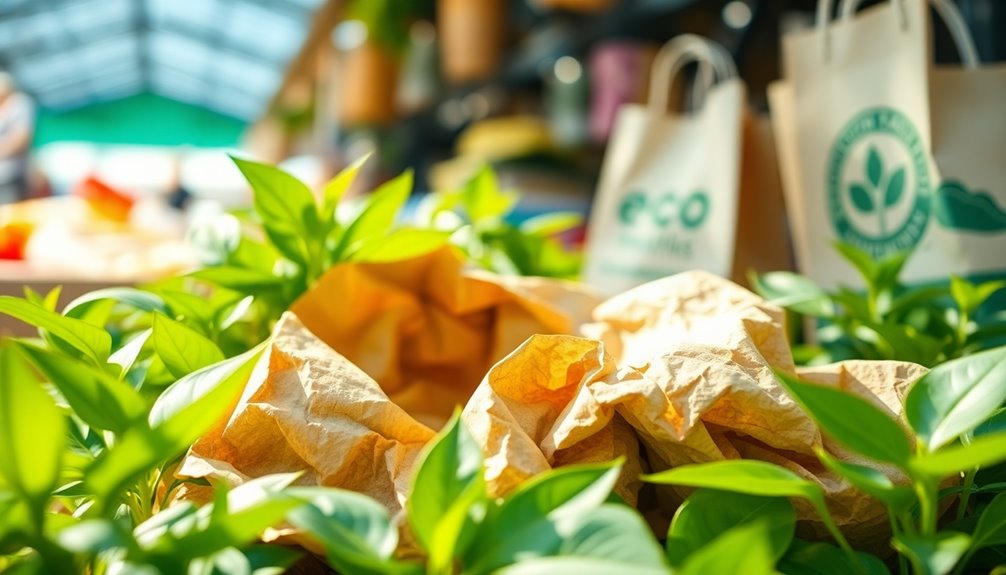
With a growing awareness of environmental issues, consumers are increasingly favoring eco-friendly packaging options. You might've noticed that many shoppers are willing to pay more for sustainable products, including kraft paper. This shift in consumer preferences highlights a surge in demand for biodegradable materials.
Brands that prioritize sustainability in their packaging choices are becoming more appealing to eco-conscious consumers like you. Kraft paper's biodegradable and compostable nature aligns perfectly with trends favoring plastic-free alternatives.
As awareness of plastic pollution grows, you may find yourself gravitating toward brands that use kraft paper, which can help differentiate their products in a crowded market. Studies reveal that companies adopting kraft paper packaging not only meet consumer preferences but also enhance their corporate social responsibility initiatives.
In today's market, you can see a clear trend: the rise of the eco-conscious consumer is prompting more companies to embrace kraft paper. This shift reflects your desire for sustainable options that contribute to a healthier planet. Additionally, the importance of personal well-being is increasingly recognized as a foundation for making eco-friendly choices that impact both individual health and the environment.
Kraft Paper in the Circular Economy

The shift toward eco-friendly packaging not only reflects consumer preferences but also plays a significant role in the circular economy. Kraft paper stands out as a sustainable choice, contributing to waste reduction and promoting ecological balance.
Here's how it fits into the circular economy:
- Biodegradable: Kraft paper is 100% biodegradable, decomposing naturally within weeks, which helps minimize landfill waste.
- Renewable Resources: It's produced from renewable materials, ensuring that it can be regrown sustainably, which supports long-term ecological health.
- Recyclability: Fully recyclable, kraft paper reduces the need for virgin materials and encourages waste diversion, making it a key player in the circular economy.
- Post-Consumer Waste: Some kraft paper products include 30% post-consumer waste, enhancing their sustainability profile and supporting circular economy initiatives.
Frequently Asked Questions
How Long Does It Take for Kraft Paper to Decompose?
When it comes to how long kraft paper takes to decompose, you'll find it generally ranges from 2 to 6 weeks.
Factors like thickness and environmental conditions play a role, too. In a composting environment, where moisture and microorganisms are present, the process speeds up considerably.
Unlike plastic, which lingers for centuries, kraft paper breaks down naturally, making it a smarter choice for environmentally conscious consumers like you.
Is Kraft Paper 100% Recycled?
Kraft paper isn't always 100% recycled, but it can be made from entirely recycled fibers. When you choose kraft paper, check the product details, as some may contain a mix of virgin and recycled materials.
If sustainability's important to you, look for options that specifically mention 100% recycled content or those with a significant percentage of post-consumer waste. This choice not only supports recycling efforts but also maintains high-quality performance for your needs.
What Type of Paper Is Most Eco-Friendly?
When you're looking for the most eco-friendly type of paper, consider kraft paper. Its production involves minimal chemicals, retaining natural fibers that guarantee strength and durability.
You'll find it's 100% compostable and biodegradable, breaking down within weeks. Plus, it's made from sustainably sourced materials, supporting forest conservation.
Can You Recycle Kraft Paper?
Yes, you can recycle kraft paper! It's 100% recyclable and fits well into most curbside recycling programs.
When you recycle kraft paper, you help break down its fibers, which can be reused to create new paper products. This process reduces the need for virgin materials, supporting sustainability.
Conclusion
To conclude, kraft paper is indeed biodegradable, making it a great choice for eco-conscious consumers. Its production process and natural materials contribute to its environmental benefits, especially when compared to other packaging options. By choosing kraft paper, you're supporting sustainable practices and reducing waste. As you explore packaging solutions, consider how kraft paper fits into your lifestyle and contributes to the circular economy. Embracing this material helps promote a greener future for everyone.

